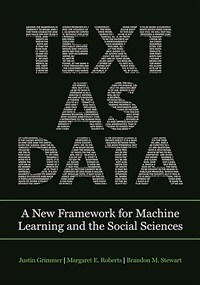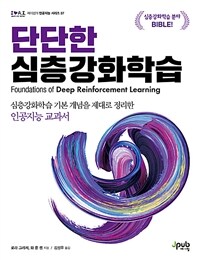
단행본
Text as data: a new framework for machine learning and the social sciences
- 저자
- Grimmer, J., Roberts, M. E., & Stewart, B. M, Grimmer, Justin, Roberts, Margaret E., Stewart, Brandon M
- 청구기호
- 006.31 TEX2022
- 발행사항
- New Jersey : Princeton University Press., 2022
- 형태사항
- 336 p
- 서지주기
- Includes bibliographical references and index
- ISBN
- 9780691207544
- 분류기호
- 듀이십진분류법->006.31
소장정보
| 위치 | 등록번호 | 청구기호 / 출력 | 상태 | 반납예정일 |
|---|---|---|---|---|
이용 가능 (1) | ||||
| 한국노동연구원 | 00009690 | 대출가능 | - | |
이용 가능 (1)
- 등록번호
- 00009690
- 상태/반납예정일
- 대출가능
- -
- 위치/청구기호(출력)
- 한국노동연구원
목차
Preface
Prerequisites and Notation
Uses for This Book
What This Book Is Not
PART I PRELIMINARIES
CHAPTER 1 Introduction
1.1 How This Book Informs the Social Sciences
1.2 How This Book Informs the Digital Humanities
1.3 How This Book Informs Data Science in Industry and Government
1.4 A Guide to This Book
1.5 Conclusion
CHAPTER 2 Social Science Research and Text Analysis
2.1 Discovery
2.2 Measurement
2.3 Inference
2.4 Social Science as an Iterative and Cumulative Process
2.5 An Agnostic Approach to Text Analysis
2.6 Discovery, Measurement, and Causal Inference: How the Chinese Government Censors Social Media
2.7 Six Principles of Text Analysis
2.7.1 Social Science Theories and Substantive Knowledge are Essential for Research Design
2.7.2 Text Analysis does not Replace Humans—It Augments Them
2.7.3 Building, Refining, and Testing Social Science Theories Requires Iteration and Cumulation
2.7.4 Text Analysis Methods Distill Generalizations from Language
2.7.5 The Best Method Depends on the Task
2.7.6 Validations are Essential and Depend on the Theory and the Task
2.8 Conclusion: Text Data and Social Science
PART II SELECTION AND REPRESENTATION
CHAPTER 3 Principles of Selection and Representation
3.1 Principle 1: Question-Specific Corpus Construction
3.2 Principle 2: No Values-Free Corpus Construction
3.3 Principle 3: No Right Way to Represent Text
3.4 Principle 4: Validation
3.5 State of the Union Addresses
3.6 The Authorship of the Federalist Papers
3.7 Conclusion
CHAPTER 4 Selecting Documents
4.1 Populations and Quantities of Interest
4.2 Four Types of Bias
4.2.1 Resource Bias
4.2.2 Incentive Bias
4.2.3 Medium Bias
4.2.4 Retrieval Bias
4.3 Considerations of “Found Data”
4.4 Conclusion
CHAPTER 5 Bag of Words
5.1 The Bag of Words Model
5.2 Choose the Unit of Analysis
5.3 Tokenize
5.4 Reduce Complexity
5.4.1 Lowercase
5.4.2 Remove Punctuation
5.4.3 Remove Stop Words
5.4.4 Create Equivalence Classes (Lemmatize/Stem)
5.4.5 Filter by Frequency
5.5 Construct Document-Feature Matrix
5.6 Rethinking the Defaults
5.6.1 Authorship of the Federalist Papers
5.6.2 The Scale Argument against Preprocessing
5.7 Conclusion
CHAPTER 6 The Multinomial Language Model
6.1 Multinomial Distribution
6.2 Basic Language Modeling
6.3 Regularization and Smoothing
6.4 The Dirichlet Distribution
6.5 Conclusion
CHAPTER 7 The Vector Space Model and Similarity Metrics
7.1 Similarity Metrics
7.2 Distance Metrics
7.3 tf-idf Weighting
7.4 Conclusion
CHAPTER 8 Distributed Representations of Words
8.1 Why Word Embeddings
8.2 Estimating Word Embeddings
8.2.1 The Self-Supervision Insight
8.2.2 Design Choices in Word Embeddings
8.2.3 Latent Semantic Analysis
8.2.4 Neural Word Embeddings
8.2.5 Pretrained Embeddings
8.2.6 Rare Words
8.2.7 An Illustration
8.3 Aggregating Word Embeddings to the Document Level
8.4 Validation
8.5 Contextualized Word Embeddings
8.6 Conclusion
CHAPTER 9 Representations from Language Sequences
9.1 Text Reuse
9.2 Parts of Speech Tagging
9.2.1 Using Phrases to Improve Visualization
9.3 Named-Entity Recognition
9.4 Dependency Parsing
9.5 Broader Information Extraction Tasks
9.6 Conclusion
PART III DISCOVERY
CHAPTER 10 Principles of Discovery
10.1 Principle 1: Context Relevance
10.2 Principle 2: No Ground Truth
10.3 Principle 3: Judge the Concept, Not the Method
10.4 Principle 4: Separate Data Is Best
10.5 Conceptualizing the US Congress
10.6 Conclusion
CHAPTER 11 Discriminating Words
11.1 Mutual Information
11.2 Fightin’ Words
11.3 Fictitious Prediction Problems
11.3.1 Standardized Test Statistics as Measures of Separation
11.3.2 χ2 Test Statistics
11.3.3 Multinomial Inverse Regression
11.4 Conclusion
CHAPTER 12 Clustering
12.1 An Initial Example Using k-Means Clustering
12.2 Representations for Clustering
12.3 Approaches to Clustering
12.3.1 Components of a Clustering Method
12.3.2 Styles of Clustering Methods
12.3.3 Probabilistic Clustering Models
12.3.4 Algorithmic Clustering Models
12.3.5 Connections between Probabilistic and Algorithmic Clustering
12.4 Making Choices
12.4.1 Model Selection
12.4.2 Careful Reading
12.4.3 Choosing the Number of Clusters
12.5 The Human Side of Clustering
12.5.1 Interpretation
12.5.2 Interactive Clustering
12.6 Conclusion
CHAPTER 13 Topic Models
13.1 Latent Dirichlet Allocation
13.1.1 Inference
13.1.2 Example: Discovering Credit Claiming for Fire Grants in Congressional Press Releases
13.2 Interpreting the Output of Topic Models
13.3 Incorporating Structure into LDA
13.3.1 Structure with Upstream, Known Prevalence Covariates
13.3.2 Structure with Upstream, Known Content Covariates
13.3.3 Structure with Downstream, Known Covariates
13.3.4 Additional Sources of Structure
13.4 Structural Topic Models
13.4.1 Example: Discovering the Components of Radical Discourse
13.5 Labeling Topic Models
13.6 Conclusion
CHAPTER 14 Low-Dimensional Document Embeddings
14.1 Principal Component Analysis
14.1.1 Automated Methods for Labeling Principal Components
14.1.2 Manual Methods for Labeling Principal Components
14.1.3 Principal Component Analysis of Senate Press Releases
14.1.4 Choosing the Number of Principal Components
14.2 Classical Multidimensional Scaling
14.2.1 Extensions of Classical MDS
14.2.2 Applying Classical MDS to Senate Press Releases
14.3 Conclusion
PART IV MEASUREMENT
CHAPTER 15 Principles of Measurement
15.1 From Concept to Measurement
15.2 What Makes a Good Measurement
15.2.1 Principle 1: Measures should have Clear Goals
15.2.2 Principle 2: Source Material should Always be Identified and Ideally Made Public
15.2.3 Principle 3: The Coding Process should be Explainable and Reproducible
15.2.4 Principle 4: The Measure should be Validated
15.2.5 Principle 5: Limitations should be Explored, Documented and Communicated to the Audience
15.3 Balancing Discovery and Measurement with Sample Splits
CHAPTER 16 Word Counting
16.1 Keyword Counting
16.2 Dictionary Methods
16.3 Limitations and Validations of Dictionary Methods
16.3.1 Moving Beyond Dictionaries: Wordscores
16.4 Conclusion
CHAPTER 17 An Overview of Supervised Classification
17.1 Example: Discursive Governance
17.2 Create a Training Set
17.3 Classify Documents with Supervised Learning
17.4 Check Performance
17.5 Using the Measure
17.6 Conclusion
CHAPTER 18 Coding a Training Set
18.1 Characteristics of a Good Training Set
18.2 Hand Coding
18.2.1 1: Decide on a Codebook
18.2.2 2: Select Coders
18.2.3 3: Select Documents to Code
18.2.4 4: Manage Coders
18.2.5 5: Check Reliability
18.2.6 Managing Drift
18.2.7 Example: Making the News
18.3 Crowdsourcing
18.4 Supervision with Found Data
18.5 Conclusion
CHAPTER 19 Classifying Documents with Supervised Learning
19.1 Naive Bayes
19.1.1 The Assumptions in Naive Bayes are Almost Certainly Wrong
19.1.2 Naive Bayes is a Generative Model
19.1.3 Naive Bayes is a Linear Classifier
19.2 Machine Learning
19.2.1 Fixed Basis Functions
19.2.2 Adaptive Basis Functions
19.2.3 Quantification
19.2.4 Concluding Thoughts on Supervised Learning with Random Samples
19.3 Example: Estimating Jihad Scores
19.4 Conclusion
CHAPTER 20 Checking Performance
20.1 Validation with Gold-Standard Data
20.1.1 Validation Set
20.1.2 Cross-Validation
20.1.3 The Importance of Gold-Standard Data
20.1.4 Ongoing Evaluations
20.2 Validation without Gold-Standard Data
20.2.1 Surrogate Labels
20.2.2 Partial Category Replication
20.2.3 Nonexpert Human Evaluation
20.2.4 Correspondence to External Information
20.3 Example: Validating Jihad Scores
20.4 Conclusion
CHAPTER 21 Repurposing Discovery Methods
21.1 Unsupervised Methods Tend to Measure Subject Better than Subtleties
21.2 Example: Scaling via Differential Word Rates
21.3 A Workflow for Repurposing Unsupervised Methods for Measurement
21.3.1 1: Split the Data
21.3.2 2: Fit the Model
21.3.3 3: Validate the Model
21.3.4 4: Fit to the Test Data and Revalidate
21.4 Concerns in Repurposing Unsupervised Methods for Measurement
21.4.1 Concern 1: The Method Always Returns a Result
21.4.2 Concern 2: Opaque Differences in Estimation Strategies
21.4.3 Concern 3: Sensitivity to Unintuitive Hyperparameters
21.4.4 Concern 4: Instability in results
21.4.5 Rethinking Stability
21.5 Conclusion
PART V INFERENCE
CHAPTER 22 Principles of Inference
22.1 Prediction
22.2 Causal Inference
22.2.1 Causal Inference Places Identification First
22.2.2 Prediction Is about Outcomes That Will Happen, Causal Inference is about Outcomes from Interventions
22.2.3 Prediction and Causal Inference Require Different Validations
22.2.4 Prediction and Causal Inference Use Features Differently
22.3 Comparing Prediction and Causal Inference
22.4 Partial and General Equilibrium in Prediction and Causal Inference
22.5 Conclusion
CHAPTER 23 Prediction
23.1 The Basic Task of Prediction
23.2 Similarities and Differences between Prediction and Measurement
23.3 Five Principles of Prediction
23.3.1 Predictive Features do not have to Cause the Outcome
23.3.2 Cross-Validation is not Always a Good Measure of Predictive Power
23.3.3 It’s Not Always Better to be More Accurate on Average
23.3.4 There can be Practical Value in Interpreting Models for Prediction
23.3.5 It can be Difficult to Apply Prediction to Policymaking
23.4 Using Text as Data for Prediction: Examples
23.4.1 Source Prediction
23.4.2 Linguistic Prediction
23.4.3 Social Forecasting
23.4.4 Nowcasting
23.5 Conclusion
CHAPTER 24 Causal Inference
24.1 Introduction to Causal Inference
24.2 Similarities and Differences between Prediction and Measurement, and Causal Inference
24.3 Key Principles of Causal Inference with Text
24.3.1 The Core Problems of Causal Inference Remain, even when Working with Text
24.3.2 Our Conceptualization of the Treatment and Outcome Remains a Critical Component of Causal Inference with Text
24.3.3 The Challenges of Making Causal Inferences with Text Underscore the Need for Sequential Science
24.4 The Mapping Function
24.4.1 Causal Inference with g
24.4.2 Identification and Overfitting
24.5 Workflows for Making Causal Inferences with Text
24.5.1 Define g before Looking at the Documents
24.5.2 Use a Train/Test Split
24.5.3 Run Sequential Experiments
24.6 Conclusion
CHAPTER 25 Text as Outcome
25.1 An Experiment on Immigration
25.2 The Effect of Presidential Public Appeals
25.3 Conclusion
CHAPTER 26 Text as Treatment
26.1 An Experiment Using Trump’s Tweets
26.2 A Candidate Biography Experiment
26.3 Conclusion
CHAPTER 27 Text as Confounder
27.1 Regression Adjustments for Text Confounders
27.2 Matching Adjustments for Text
27.3 Conclusion
PART VI CONCLUSION
CHAPTER 28 Conclusion
28.1 How to Use Text as Data in the Social Sciences
28.1.1 The Focus on Social Science Tasks
28.1.2 Iterative and Sequential Nature of the Social Sciences
28.1.3 Model Skepticism and the Application of Machine Learning to the Social Sciences
28.2 Applying Our Principles beyond Text Data
28.3 Avoiding the Cycle of Creation and Destruction in Social Science Methodology
Acknowledgments
Bibliography
Index





